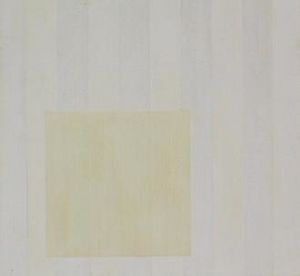Mino Argento facts for kids
Quick facts for kids
Mino Argento
|
|
|---|---|
| Born | January 5, 1927 Rome, Italy
|
| Nationality | Italian, American |
| Known for | Painter, architect |
| Movement | Abstract expressionism, lyrical abstraction, geometric abstraction, minimal art, impressionism, collage, monochrome painting |
Mino Argento (born January 5, 1927) is an Italian painter. He is known for his abstract art, which means his paintings do not show real-life objects. He creates his art using canvas and paper.
Contents
Life and Art Journey
Mino Argento was born in Rome, Italy. He first studied to become an architect. In 1968, he showed his paintings for the first time at a gallery in Rome.
Before 1969, Argento painted in a "figurative" style. This means his art showed real people or objects. He moved to New York City in 1969. He wanted to try new ways of painting that were not expected in Europe. America offered him more freedom to explore.
Starting in New York
After moving to New York, Argento had his first solo art show in 1974. This was at the Livingston-Learmonth Gallery. He was the very first artist to show his work there. Later, famous galleries like Betty Parsons Gallery also showed his art.
During the 1970s, his paintings were displayed next to many well-known artists. These included Frank Stella, Richard Pousette-Dart, and Giorgio de Chirico. His work was even part of one of the last shows at the Betty Parsons Gallery in 1983.
Mino Argento's Painting Style
In the 1960s, Argento used oil paints and collage in his art. Collage is when you stick different materials onto a surface. Later, in the 1970s and 1980s, he started using acrylic paint and a special white paint called gesso.
He often painted thin layers of gesso on his canvases. This made the surface look almost gray. He liked to play with "positive" and "negative" space in his art. This means he thought about both the main shapes and the empty spaces around them.
Argento often mixed hard pencil lines with soft layers of oil paint. He built up the white gesso, sometimes adding oil paint. This made his paintings look like collages. He carefully balanced the light and dark parts of his art with his pencil lines.
His paintings often used a lot of white. But they were not just about "being white." They were about the absence of color. His background in architecture also influenced his art. You can often see a sense of geometry, or shapes, in his paintings.
Helping Friuli After the Earthquake
In 1976, a big earthquake hit Friuli, Italy. Mino Argento joined many American artists to help. They donated a large collection of paintings and sculptures. This was a way to show international support.
This project helped strengthen the friendship between Italy and America. The donated artworks are now part of a permanent collection. They are kept in the towns in Friuli that were affected by the earthquake.
Art Shows and Exhibitions
Mino Argento's art has been shown in many places around the world.
Solo Exhibitions
These are shows where only Mino Argento's art was displayed.
- 1965, Condotti Gallery, Rome, Italy.
- 1966, Realschule Gallery, Vaduz.
- 1968, Galleria Astrolabio, Rome.
- 1974, Livingston-Learmonth Gallery, New York City.
- 1977, Betty Parsons Gallery, New York City.
- 1979, Betty Parsons Gallery, New York City.
- 1987, J. P. Natkin Gallery, New York City.
- 1988, Sgro-Riddle Gallery, Los Angeles.
Group Exhibitions
These are shows where Mino Argento's art was displayed with other artists.
- 1965, 1966, Burckardt Gallery, Rome.
- 1966, Porfirius Gallery, Rome.
- 1968, Guglielmi Galleria, San Benedetto del Tronto, Italy.
- 1967-1970, Galeria Astrolabio, Rome.
- 1975, 1976, Livingstone-Patricia Learmonth Gallery, New York City.
- 1975, Group Exhibition, OK Harris Gallery.
- 1977, Betty Parsons Gallery, New York City.
- 1978, Betty Parsons Gallery, New York City.
- 1978, "7 American Artists, 7 European Artists" in Deauville, France.
- 1979–80, Betty Parsons Gallery, New York City.
- 1979, Nardin Gallery, New York. (Show of Contemporary Italian art).
- 1980, "Contemporary American Art" in Udine, Italy.
- 1980, Sneed Gallery, Rockford, Illinois.
- 1980, Betty Parsons Gallery, New York.
- 1981, Betty Parsons Gallery, New York.
- 1982, Ericson Gallery, New York City.
- 1983, "PAINTING" group show, Betty Parsons Gallery, New York.
- 1983, "Group 2", Betty Parsons Gallery.
Selected Artworks
Here are some of Mino Argento's paintings.
Late 1950s and Early 1960s Works
- La Tigre (The Tiger), 1968.
- Donna col Drappo Giallo (Woman with Yellow Drape), 1968.
- Bagnanti (Bathers), 1968.
- Sul Tappeto Giallo (The Yellow Carpet), 1968.
- Ragazza Sul Letto (Girl On Bed), 1968.
- Nudo (Naked), 1968.
- Figura Giacente (Lying Figure), 1968.
- Donna Accovacciata (Woman Squatting), 1968.
- Beauty Salon, 1968.
- Donna e Macchina (Woman and Machine), 1968.
- Donna e Frutta (Woman and Fruit), 1968.
- Natura Morta (Still life), 1968.
- Pupazza (Puppet), 1968.
- Melanzane (Eggplant), 1968.
- Il Foglio Bianco (The white paper), 1968.
- Scena di Caccia (Hunting Scenes), 1968.
- Toro al Mattatoio (Bull at Slaughterhouse), 1968.
- La Monta (The Mount), 1968.
- Piccolo Toro n.1 (Small Bull No.1), 1968.
- Piccolo Toro n.2 (Little Bull No.2), 1968.
- La grande Bestia (The Great Beast), 1968.
- Paesaggio (Landscape), 1968.
Late 1960s and Early 1970s Works
- Untitled, 1973.
- New York, 1973.
- New York #2, 1973.
- Untitled, 1976.
- Untitled, 1977.
- Untitled or (New York), 1977.
- Labyrinthus II, 1978.
- Fragments of a Paradox, 1979.
- Janus Two Headed, 1979.
- Spectrum at 90o, 1979.
- Construction of Three Alternatives, 1979.
1980s and Later Works
- Untitled, 1986.
- Inquietudine Geometria, 1987.


